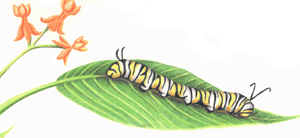 HOME: www.hiltonpond.org |
|||
|
WELCOME THEM WITH MILKWEEDS |
|
Nancy Brachey, Garden Editor Now, as survivors fly north in their spring migration, experts have advice for area gardeners who want to help the beleaguered beauties.
January's deadly freeze descended on two major winter resting grounds of the monarch in Mexico. The grounds are located on mountaintops mostly in Michoacan state, about a three-hour drive west of Mexico City. "It is, for sure, one of the largest die-offs ever," says Seriff. "They had a die-off in the early 1980s of 2 to 3 million because of a severe winter storm, but this is far more catastrophic." Naturalists who visited the grounds following the freeze reported enormous losses of as many as 250 million monarchs. They said about 74 percent died at one resting ground and 80 percent at another. Logging in the areas in recent years has thinned the fir forests that shelter the monarchs. Long-term effects aren't yet known. "That's being debated (among naturalists) right now," says Seriff. "Some people feel like if the area isn't protected, and there isn't an overall increase in the wintering population, there could be a long-term decline. "It still remains to be seen." Naturalists say gardeners who love the distinctive black-and-orange butterflies can easily contribute to their well-being. "The best thing folks can do to help monarchs locally is to provide plantings for them," says naturalist Bill Hilton Jr., of York, S.C. "It would be wonderful if ... every gardener put in a few plants specifically for monarchs." That means milkweed, which belongs to the genus asclepias and comes in a number of native species. The best-known is butterfly weed, Asclepias tuberosa, widely sold in spring in garden centers. Another favorite of the monarch, he says, is common milkweed, Asclepias syriaca. They grow best in full sun and soil on the sandy side, says Hilton. The swamp milkweed, Asclepias incarnata, grows in wet spots. Hilton encourages gardeners to plant milkweed plants because established plantings of the Piedmont are being lost to development. Seriff points out that the monarch can be seen in the city as well as the country. "I've seen them migrate through the Cotswold shopping center. In North Carolina, they tend to be most common from August through the end of October, but you can see them anytime from spring through the first of November." Their travels from Mexico north through the Eastern United States into Canada and back are a lesson in multi-generational migration. The spring migration is dependent on bloom of the milkweed, says Seriff. "If they go too early, there's no milkweed for them. As they move north, they lay eggs, which hatch into a new generation, and so on. It's usually the third or fourth generation that somehow knows to return south to warm Mexico." At the same time, the insect's reproductive capacity is suppressed so that it concentrates only on moving south, feeding on nectar of milkweed and other plants along the way. "It's an amazing strategy, a one-of-a-kind way of survival and a real mystery how it all evolved over tens of thousands of years," he says. Another way the monarch survives is through its attachment to milkweed. By feeding on milkweed and absorbing some of its toxins, which have a terrible taste, the monarch makes itself unappetizing to predators, chiefly birds and bats, says Seriff. "It's interesting that a bird will taste a monarch, spit it out and learn from that experience not to feed on another of them. The toxin may not protect that individual butterfly, but it does protect the species overall." Helping to support the monarch now and in years to come will also help other butterflies. There are 76 known species in Mecklenburg county, 95 in Gaston. Seriff says. "We encourage everybody to help with conservation of all butterflies, not just the monarch. If you encourage all butterflies, and plant milkweed for the monarch, you will be helping it, too." |
 "Each person doing a little bit adds up to a lot being done," says Don Seriff, conservation supervisor for Mecklenburg County's Division of Natural Resources. Mainly, that means planting milkweed, which is mother's milk for monarchs; avoiding pesticides and protecting caterpillars.
"Each person doing a little bit adds up to a lot being done," says Don Seriff, conservation supervisor for Mecklenburg County's Division of Natural Resources. Mainly, that means planting milkweed, which is mother's milk for monarchs; avoiding pesticides and protecting caterpillars.


